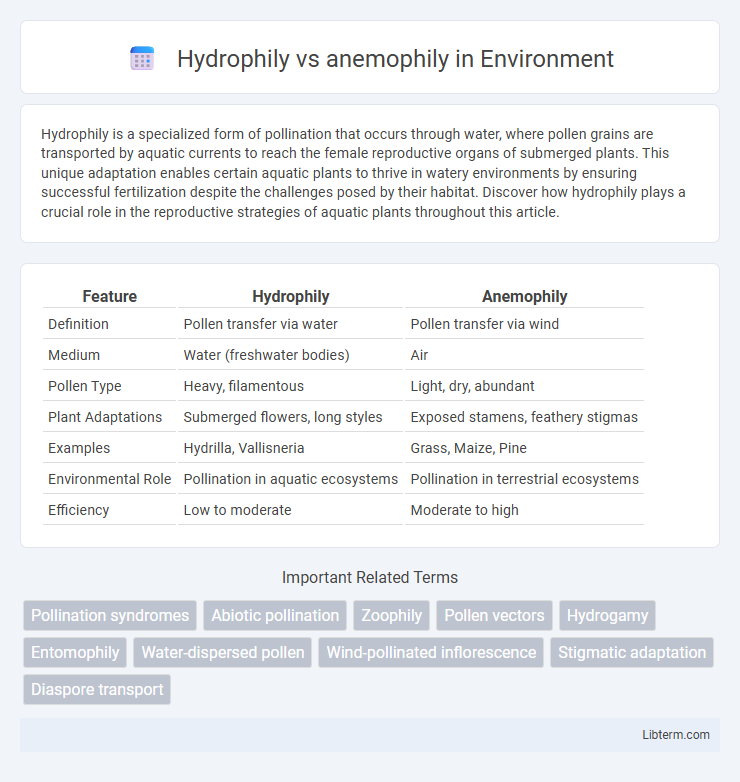Hydrophily is a specialized form of pollination that occurs through water, where pollen grains are transported by aquatic currents to reach the female reproductive organs of submerged plants. This unique adaptation enables certain aquatic plants to thrive in watery environments by ensuring successful fertilization despite the challenges posed by their habitat. Discover how hydrophily plays a crucial role in the reproductive strategies of aquatic plants throughout this article.
Table of Comparison
| Feature | Hydrophily | Anemophily |
|---|---|---|
| Definition | Pollen transfer via water | Pollen transfer via wind |
| Medium | Water (freshwater bodies) | Air |
| Pollen Type | Heavy, filamentous | Light, dry, abundant |
| Plant Adaptations | Submerged flowers, long styles | Exposed stamens, feathery stigmas |
| Examples | Hydrilla, Vallisneria | Grass, Maize, Pine |
| Environmental Role | Pollination in aquatic ecosystems | Pollination in terrestrial ecosystems |
| Efficiency | Low to moderate | Moderate to high |
Introduction to Hydrophily and Anemophily
Hydrophily and anemophily are specialized pollination mechanisms adapted to distinct environments. Hydrophily involves pollination through water, commonly found in aquatic plants like Vallisneria, where pollen grains float on the water surface to reach the stigma. Anemophily, by contrast, depends on wind for pollen transfer and is typical in species such as grasses and many trees, with lightweight, aerodynamic pollen designed for efficient aerial dispersal.
Defining Hydrophily: Water-Based Pollination
Hydrophily is a specialized form of pollination where pollen transfer occurs through water, primarily in aquatic plants such as Hydrilla and Vallisneria. This water-based pollination mechanism allows pollen grains to travel via water currents, ensuring fertilization despite submerged or floating floral structures. Unlike anemophily, which relies on wind for pollen dispersal, hydrophily adapts plants to aquatic environments by utilizing water as the medium for transporting male gametes effectively.
Understanding Anemophily: Wind-Based Pollination
Anemophily, or wind pollination, relies on the movement of air currents to transfer pollen grains from the male anthers to the female stigmas of flowers, bypassing the need for animal pollinators common in hydrophily. Plants adapted to anemophily, such as grasses, conifers, and many cereal crops, produce large quantities of lightweight, smooth pollen to maximize dispersal efficiency over wide areas. This mechanism enhances cross-pollination and genetic diversity but demands specific structural flower adaptations like exposed stamens and feathery stigmas to capture airborne pollen effectively.
Key Differences Between Hydrophily and Anemophily
Hydrophily involves pollination through water, primarily occurring in aquatic plants where pollen grains are transported by water currents, while anemophily relies on wind to disperse lightweight pollen over long distances. Hydrophilous pollen is often elongated or filamentous to enhance buoyancy, contrasting with the dry, smooth, and small pollen typical of anemophilous species. The ecological adaptations also differ: hydrophilous plants tend to produce fewer flowers with sticky pollen suited for water, whereas anemophilous plants produce copious amounts of pollen to compensate for wind's unpredictability in pollen delivery.
Adaptations in Hydrophilous Plants
Hydrophilous plants exhibit key adaptations such as slender, flexible pollen that can float and survive in aquatic environments, enabling effective water-mediated pollination. Their flowers are often reduced or lack showy petals, reflecting the absence of the need to attract pollinators, and have stigmas positioned to intercept pollen carried by water currents. In contrast to anemophilous plants that rely on wind-dispersed, lightweight pollen with smooth surfaces, hydrophilous species possess pollen and reproductive structures uniquely suited to water transport and fertilization.
Structural Features of Anemophilous Plants
Anemophilous plants exhibit structural features such as small, inconspicuous flowers with exposed stamens and large, feathery stigmas to effectively capture airborne pollen. Their flowers typically lack nectar and bright colors, reflecting adaptation to wind pollination rather than animal attraction. The lightweight, abundant pollen grains are produced in large quantities to increase the chances of successful fertilization through wind dispersal.
Examples of Hydrophilous and Anemophilous Species
Hydrophily, or water pollination, is exemplified by aquatic plants such as Vallisneria and Zostera, which release pollen into water currents for fertilization. Anemophily, or wind pollination, is typical in species like maize (Zea mays), grasses, and many conifers, where lightweight pollen grains are dispersed by wind. These distinct pollination mechanisms highlight adaptations to their environments, with hydrophilous plants thriving in aquatic habitats and anemophilous plants dominating open, terrestrial ecosystems.
Ecological Significance of Hydrophily and Anemophily
Hydrophily, the water-based pollination mechanism, plays a crucial ecological role in aquatic ecosystems by enabling plant reproduction in submerged or floating species, ensuring genetic diversity and survival in aquatic habitats. Anemophily, or wind pollination, supports terrestrial ecosystems by facilitating pollen dispersal over long distances, promoting cross-pollination among grasses, trees, and many agricultural crops, thus maintaining biodiversity and ecosystem stability. Both hydrophily and anemophily contribute to ecosystem resilience by adapting reproductive strategies to specific environmental conditions, optimizing plant propagation in water and air dominant habitats.
Challenges and Limitations of Water and Wind Pollination
Water pollination (hydrophily) faces challenges such as limited pollen dispersal distance and dilution effects, which reduce fertilization efficiency in aquatic plants. Wind pollination (anemophily) encounters issues including pollen wastage due to uncontrollable dispersal and susceptibility to environmental factors like humidity and wind speed. Both mechanisms struggle with precise targeting of pollen to female reproductive structures, impacting reproductive success rates.
Conclusion: Comparing the Efficiency of Hydrophily and Anemophily
Hydrophily, the process of water-mediated pollen transfer, is highly efficient in aquatic environments due to the direct movement of pollen on or beneath the water surface, minimizing pollen loss. Anemophily relies on wind for pollen dispersal, which enables widespread distribution but often results in significant pollen wastage due to its random and passive nature. Comparing both, hydrophily proves more targeted and efficient in aquatic habitats, while anemophily benefits terrestrial plants requiring broader pollen dispersal despite lower transfer precision.
Hydrophily Infographic

 libterm.com
libterm.com